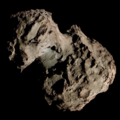 Comet C/2020 R4 (ATLAS) photographed by the Zwicky Transient Facility on 2 April 2021. | |
| Discovery [1] | |
|---|---|
| Discovery site | ATLAS–MLO (T08) |
| Discovery date | 12 September 2020 |
| Designations | |
| CK20R040 | |
| Orbital characteristics [2] | |
| Epoch | 13 March 2021 (JD 2459286.5) |
| Observation arc | 1.50 years |
| Earliest precovery date | 29 August 2020 |
| Number of observations | 2,399 |
| Aphelion | 192.40 AU |
| Perihelion | 1.029 AU |
| Semi-major axis | 96.713 AU |
| Eccentricity | 0.98936 |
| Orbital period | ~950 years |
| Inclination | 164.46° |
| 323.27° | |
| Argument of periapsis | 46.708° |
| Mean anomaly | 0.011° |
| Last perihelion | 1 March 2021 |
| Next perihelion | ~2970s |
| TJupiter | –1.155 |
| Earth MOID | 0.117 AU |
| Jupiter MOID | 0.023 AU |
| Comet total magnitude (M1) | 12.8 |
| Comet nuclear magnitude (M2) | 15.6 |
C/2020 R4 (ATLAS) is a long-period comet with a roughly 950-year orbit around the Sun. It is one of many comets discovered by the Asteroid Terrestrial-impact Last Alert System (ATLAS).

